We reached the bottom of the iconic cables on the Half Dome hike, and I was completely awestruck. My friend and I had hiked nearly 8 miles and up 4,400 feet of insanely steep terrain, over the past five hours. Now, we stood 400 feet below the summit. I arched my neck to gaze up: the scale and abruptness of the granite monolith took my breath away—it was gorgeous and overwhelming. It also looked completely vertical.
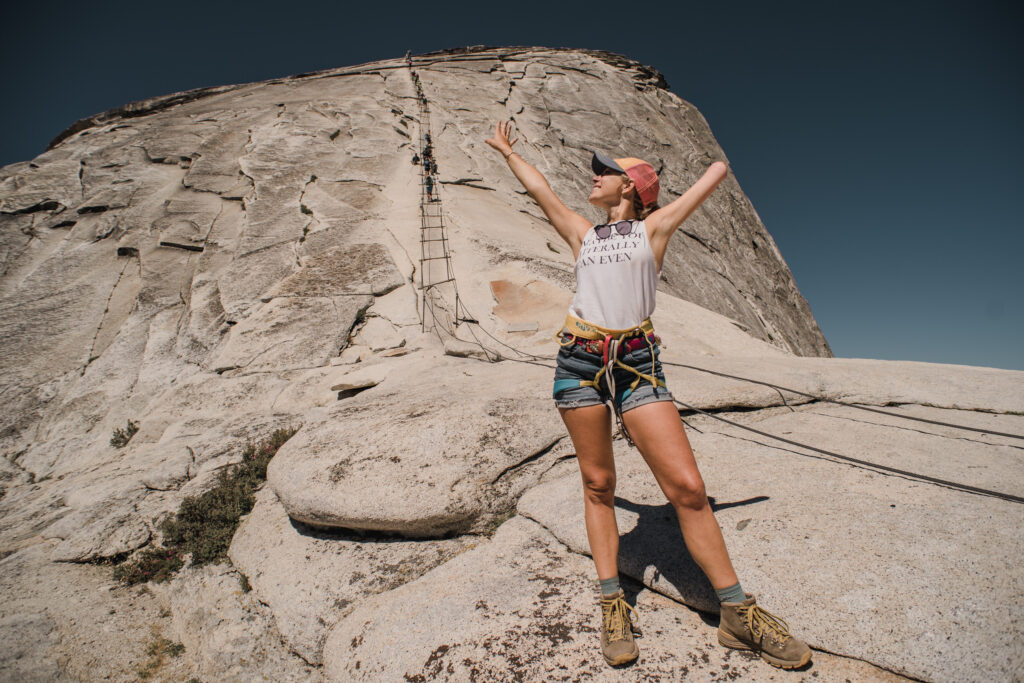
A switch flipped, and I started to freak out. Yes, I was fit and strong. But mentally, panic consumed my focus and took 30 minutes to subdue. I did not have a harness or safety gear to clip into the cables. I did not have gloves for friction. My hiking partner had a great attitude but was not feeling so hot, either. I should have more experience to be here, I realized. We started our way up the cables, anyway—and it nearly ended in catastrophe.
Don’t let my gut-wrenching experience (or worse) be yours. In this post, I’ll cover everything you need to know so that you can be prepared to hike Half Dome safely.
My First Experience Hiking the Half Dome Cables
When I lived in L.A., I became really passionate about hiking and pursued the SoCal Six-Pack. The hiking challenge includes six peaks: Mount Wilson, Cucamonga Peak, Mount San Antonio (a.k.a. Mount Baldy), San Bernardino, Mount San Jacinto, and San Gorgonio Peak. All together, the routes accumulate 82 miles and more than 27,000 feet of vertical gain. I started the checklist solo on Mount Baldy, in 2015. On day one, I became good friends with these two guys, who had also just started the challenge. We ended up hiking the entire Six-Pack together. Afterwards, they invited me to Yosemite National Park to hike Half Dome, which I knew nothing about, other than it looked pretty scary.
So, I studied the Mr and Mrs Adventure blog. The post was written by a woman who seemed to be my fitness level. She broke the goal down into digestible pieces. I’d just finished the Six-Pack, and my physical endurance was high. My confidence had skyrocketed. I can tackle this long hike, too, I thought. My hiking tribe and I applied for the Half Dome lottery. I recruited my best friend to request a permit, too. He was not a hiker but was incredibly supportive of me—and he won. My hiking buddies and I didn’t get permits, so they dropped out. My friend bought his hiking boots the night before we left. We arrived at Upper Pines Campground, next to the Happy Isles Trailhead, at 1 a.m. After four hours of sleep, we started our hike, pre-dawn.
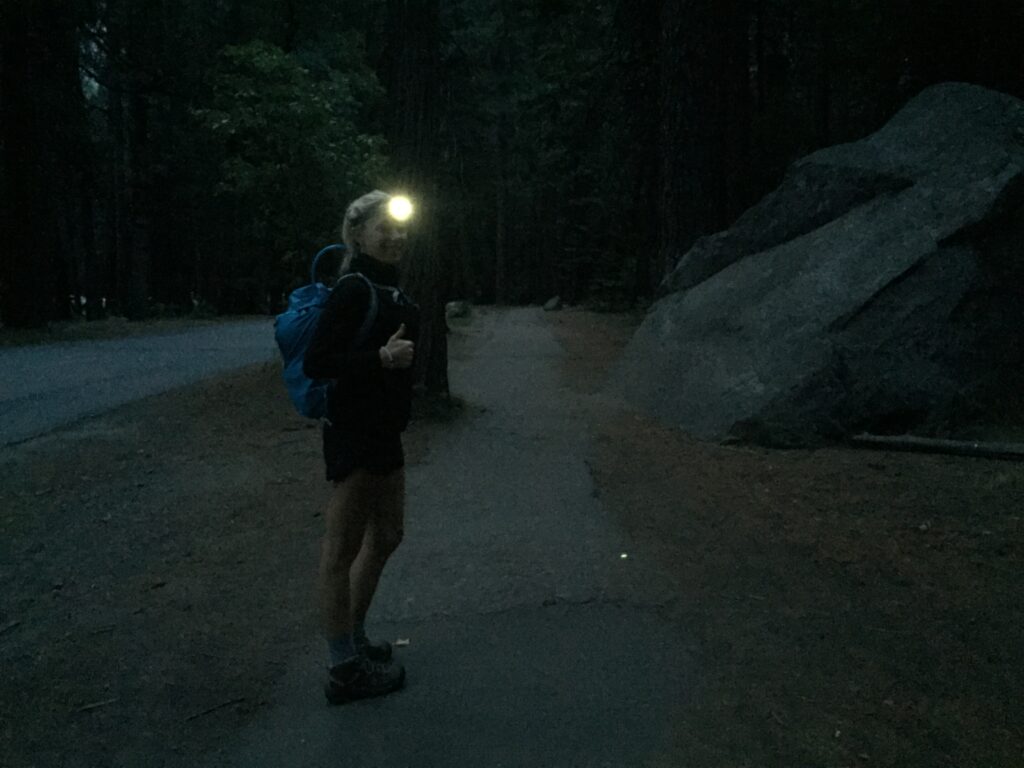
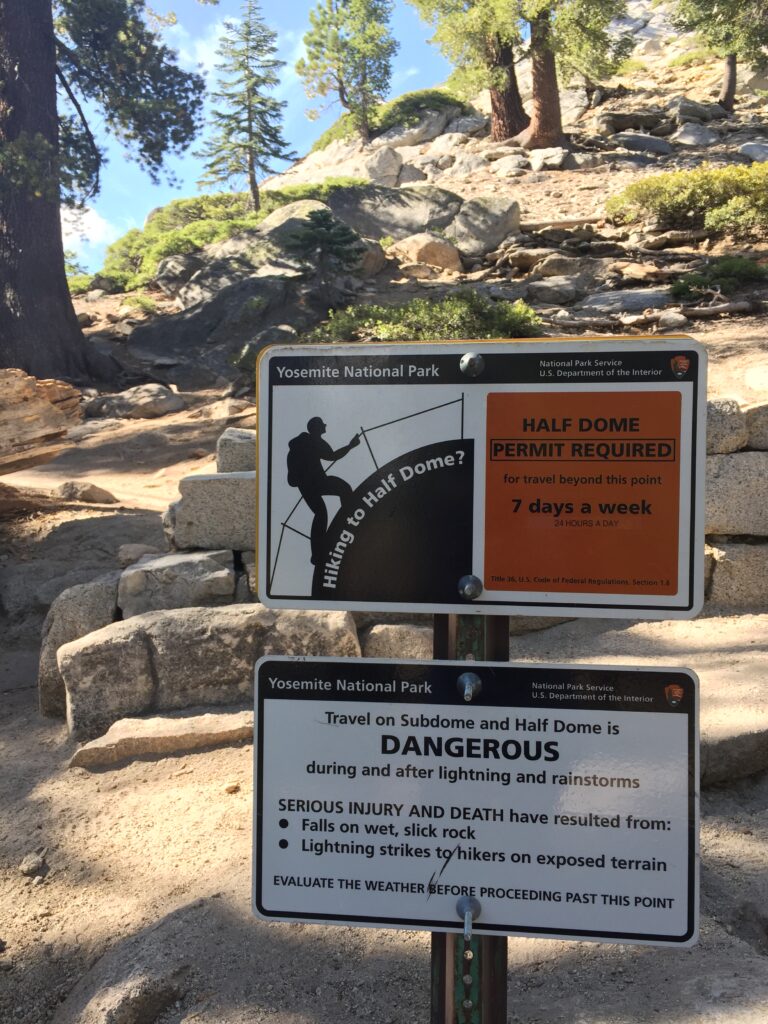
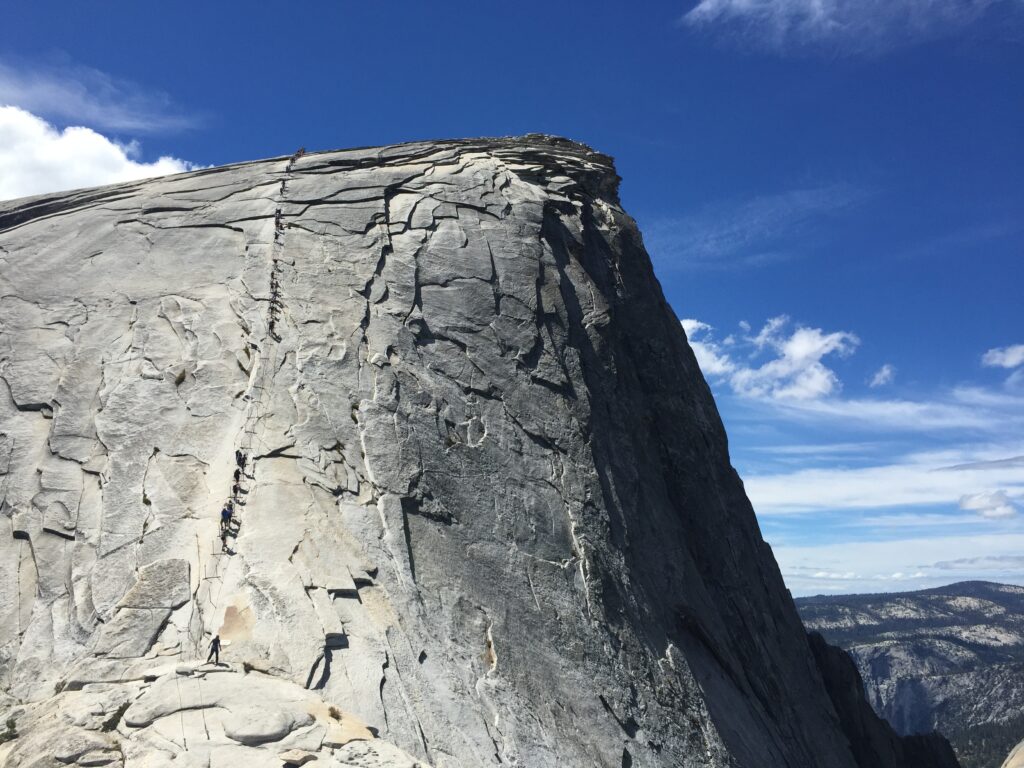
By 11:30 a.m., we were ascending the cables. The rows are about two arm’s-length apart, so I couldn’t reach both sides. With one cable gripped in my hand, I slowly moved up. Beneath me, the ladder was constructed with 2-inch-by-2-inch strips of wood, which were bolted into the face. Each step was spaced really far apart. Some of the boards were loose, wobbly, or barely attached. The cable was slick and coated with the oil of countless hands. Then, the route became gradually more sheer. After 150 feet, I reached the crux, where the rock became extremely perpendicular, and I froze. I started to cry. My friend tried to help encourage me forward. I can’t do this, I thought.
I clung to the metal cable, seized in fear. Until, finally, I heard a calm voice behind me. “Do you mind if I help you up? I have a daughter your age who we’ve brought here,” said the man. He stood slightly beneath and behind me with his arms spread cable-to-cable and said, “If you need to lean back on me, I’m secure. I won’t let you fall.” I was comforted by his presence and ability to catch me. So, I started to climb. At one rung, the gap was too large for me to step up, so he gave me a push. At the top, I burst into tears—I was immensely relieved to be on flat ground. I turned around and finally met my savior, Bruce. To this day, he is a dear friend and mentor. And, he helped me descend, too. By the time we reached our camp that evening, my legs were jello and my knees ached from the steep descent. I’d also never felt so accomplished in my life.
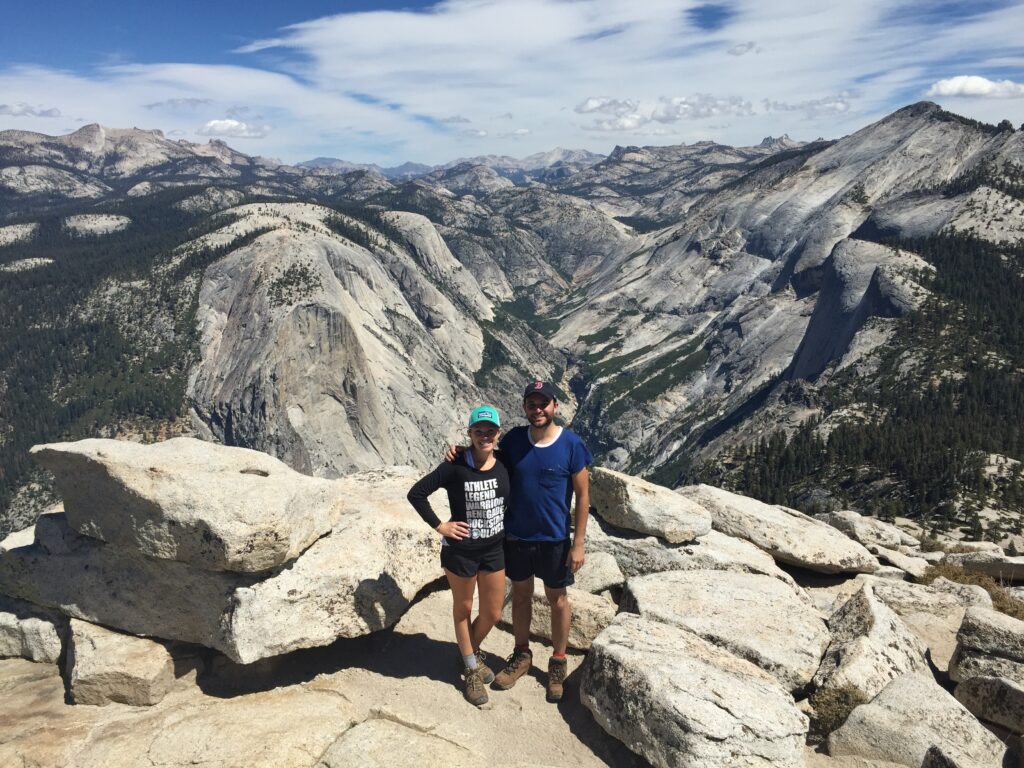
Is Safety An Issue on the Half Dome Cables?
My experience on Half Dome sparked a curiosity to dig into the data. Was hiking Half Dome and the cables as serious as I perceived it to be? Evidence points that decade over decade, fatalities on this hike are becoming more common. For the safety of ourselves and those around us, we need to be more honest about the risks.
Fatalities on Half Dome
Over an 85-year period, 31 deaths occurred on Half Dome, according to Wilderness and Environmental Medicine. Among those tragedies, 10 were related to hiking and the cable handrails. At least two more fatalities have occurred on the cables since that article was published in April 2018, bringing the total lost lives to twelve.
My second question: Did a permit system, which was introduced in 2010, successful make the Half Dome hike safer?
Hikers perceive that they are safer when less than 70 people are on the cables route, according to NPS research. In actuality, though, the same number of incidents and fatalities have continued to occur after the permit system was introduced but with 56% fewer participants. Meaning, the relative risk doubled, according to the Wilderness Medical Society (WMS):
“The use of permits appears to have increased the individual risk for a search and rescue incident. It is possible that the exclusivity of obtaining a permit—with a 20% success rate— increases motivation or risk-taking behavior for the individual attempting to summit….The publicity generated by the permit system might attract a broader audience with a different fitness or experience profile,” states the 2019 report.
Beyond fatalities, search and rescue (SAR) personnel help hikers for a variety of reasons. Typically, hikers get into trouble after they ascend out of Little Yosemite Valley, which is about 3.5 miles into the hike. For context, SAR responded to more than 139 incidents that took place between Little Yosemite Valley and the summit, from 2005 to 2015. The most common problems that led to rescues were gastrointestinal illness, lower extremity injuries, lost individuals, and vomiting (heat and altitude can be an issue).
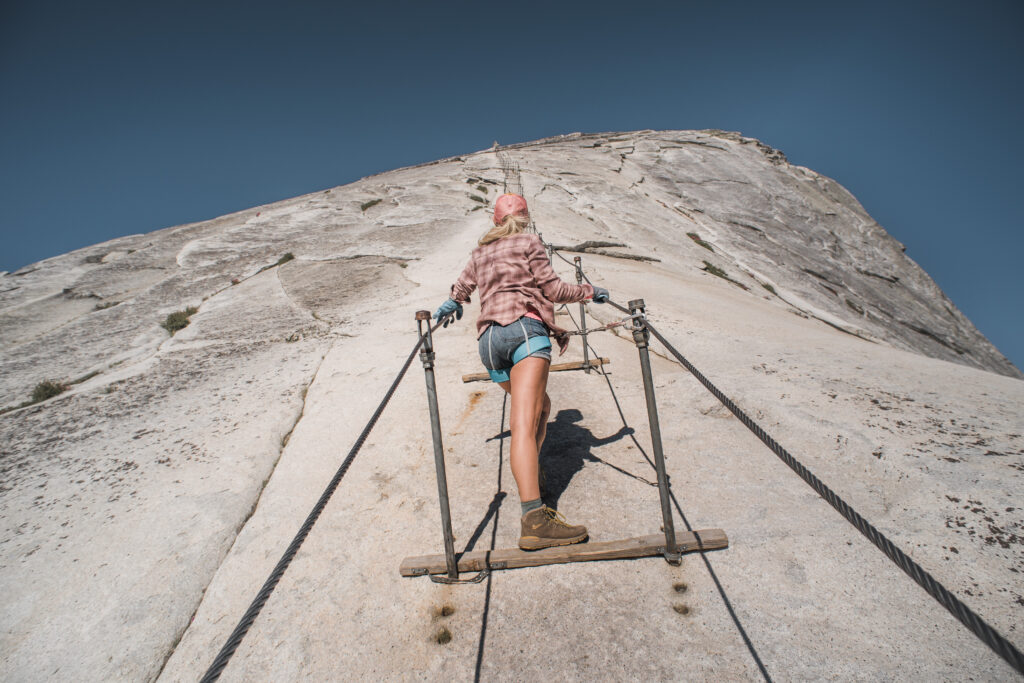
Notable Hazards on the Half Dome Cables
1.) Technical Climbing Gear is NOT Required—but should be
Flash forward two years, and I returned to the Half Dome cables with Dylan. Permit-holders are not required to use any technical climbing or safety gear on the cables, which is mind-boggling to me. But this time, I brought gear and clipped myself in. Here’s the caveat: You STILL need to do everything possible to avoid a fall. If you slip or stumble backward, a horrible domino effect could hurt and endanger the people around you.
2.) Falling objects
For that second climb, I was mentally calmer and more prepared. I noticed a lot of fresh details—including several avoidable, unsafe behaviors. First, a water bottle fell out of someone’s pack above and shot by us. Then, mid-climb, a group of twenty-somethings disrespectfully pushed passed people on the cables. One of them was wearing sandals and could have easily slipped. Those personal choices heightened the exposure for everyone else. Ultimately, if the unthinkable happened, there was no ranger at the bottom of the cable handrails to help.
Overall, it also seemed that far more people were climbing the cables compared to my first experience, two years prior. Maybe it was just timing. According to the 2012 National Park Service “Half Dome Trail Visitor Use Monitoring Report,” the most crowded day on the cables route saw 1,300 visitors, in 2009—which I CAN’T imagine! With the permit system, only 300 hikers can approach the route per day. As a result, the flow of climbers steadily increases throughout the day and peaks—at about 65 people—on the cables between 1 and 2 p.m. Well, that’s still a big crowd on a narrow one-way climb with two-way traffic!
To mitigate and plan ahead for these risks:
- Use a harness, via ferrata set, and gloves
- Store ALL of your belongings inside your pack
- Move mindfully up and down the cables; don’t rush; Be courteous and respectful to other groups
- Wear proper protective footwear with traction
- Start the hike before dawn to avoid the mid-afternoon rush hour on the cables
- Have an emergency plan; don’t depend on a ranger or cell service being present
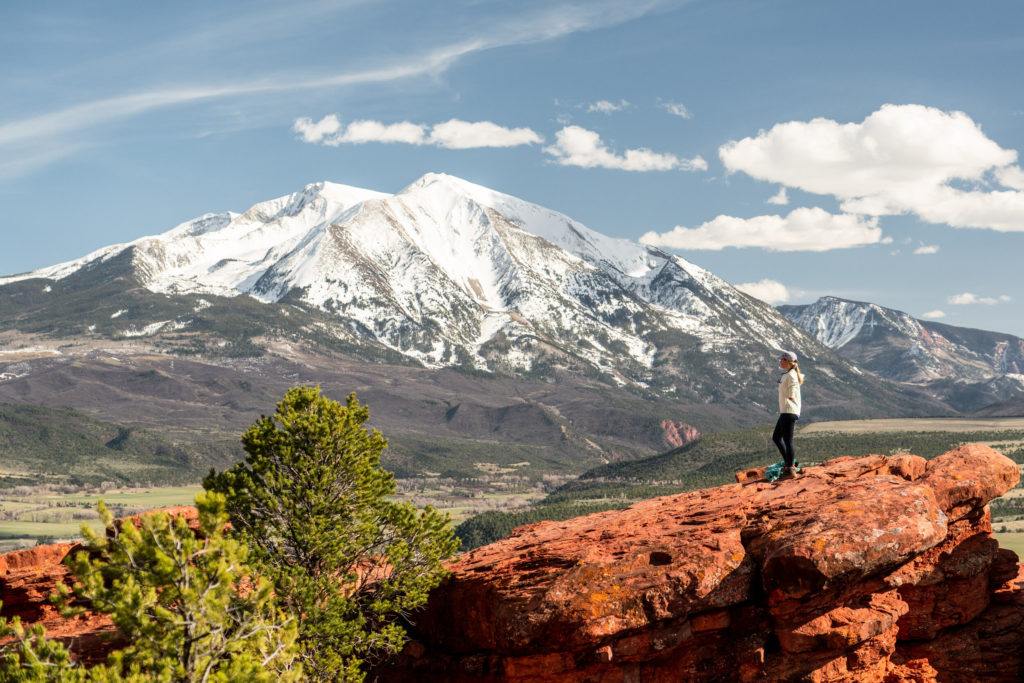
How to Physically Train for the Half Dome Hike
This entire hike is ANYTHING BUT EASY—even before you reach the cables. The route is 14- to 16 miles round-trip, contingent on a slight trail variation in the middle of the hike. There is also 4,800 feet of elevation gain, which tops out at a high altitude of 8,800 feet. Most people need 10 to 12 hours to complete the entire hike.
Set up your success by building cardiovascular fitness and endurance long before you head to Yosemite. Every person’s body is unique. If you’ve never done a long hike, consider working with a personal trainer to design a plan that supports your personal health and schedule. And I strongly recommend hiking at least once per week, ideally at high altitude. Again, the Half Dome summit is nearly 8,800 feet above sea level, so hikers occasionally suffer from altitude sickness.
Are You Ready for the Half Dome Cables?
Hiking and climbing Half Dome is a huge mental game—it’s not just physical. “A lot of people have fear of heights, and Half Dome can be a mentally messy hike,” says Lindsay Gurley, a certified, adventure-based life coach and professional mountain guide. For more than a decade, Gurley has led clients on backpacking, hiking, and rock climbing routes. To examine your mental strength, Gurley suggests hiking trails near home that contain exposure. Start those hikes at least a few months before your permit day.
Have you taken training courses?
To learn about climbing gear and safety equipment—which I will never again go without—as well as risk management, take a class. “Look at the day courses for climbing offered at your local community college, REI Co-op, climbing gym, or NOLS. Learn from a professional. If you go to YouTube university, you’re not getting the practical in-person skills. If you can’t do a class, hire a guide for a day and learn the systems,” says Gurley. Or, consider hiring a guide for your day on Half Dome: “A guide is someone you know you’re safe with and knows how to safely take you,” she adds.
Have you trained, physically?
Training routines for Half Dome are tailored to each person’s body and health. When Gurley coaches clients, she encourages them to be self-aware and honest about their fitness, strengths, and weaknesses, so that they can achieve their goal. For instance, “Are you running, hiking, and biking 4-5 days a week? That’s way different than someone going to the gym for 30 minutes, five days a week. If you go to yoga three days a week and run one day a week, you need to instead run a 5K three days a week and do at least one hike a week, so that you’re at least clocking 12 miles per week,” says Gurley. For a big objective like Half Dome, start training six months in advance including cross-training to strengthen the legs and muscles around the joints.
Your outdoor portion of training should mirror the Half Dome route, in order to prepare your body for that movement and impact. “You want to be able to hike up at a steady incline—a 5-6% grade— for 5 miles but with roots, rocks, and an imperfect path. Could you do that for five hours? And then, would your knees and ankles be able to handle going back down?” Says Gurley. Consider hiring a personal trainer who can objectively get you ready for your big climb, motivate, and provide accountability.
“You have to be brutally honest with yourself: This isn’t going to be easy. You have to train to be fit. Physical preparation is really important,” explains Gurley. Also, if you’re arriving at Half Dome from lower elevations, be extremely cautious about altitude sickness. Know the warning signs, so that you can turn around and descend.
Are you psychologically prepared and aware?
Psychologically, assess your purpose. “What’s motivating you? Is it your ego or is there a deeper desire or inspiration that you are willing to work forward with? Are you willing to turn around when shit goes bad, the weather turns, or you’re not fit? If you’re just going for Instagram photos then rethink it. Make sure you’re going for the right reasons,” says Gurley.
Ultimately, “Don’t get off the desk and go to Half Dome…If you need emergency help, you’ll put dozens of lives of search and rescue operatives in danger to come after you.”
In addition to safety skills, make sure you are ready physically, mentally, and psychologically for this journey. If you check those boxes and give yourself time to safely progress, you’ll be strong and standing atop Half Dome’s summit in no time.
For training or coaching, follow and reach out to Gurley at @lindsay__gurley.
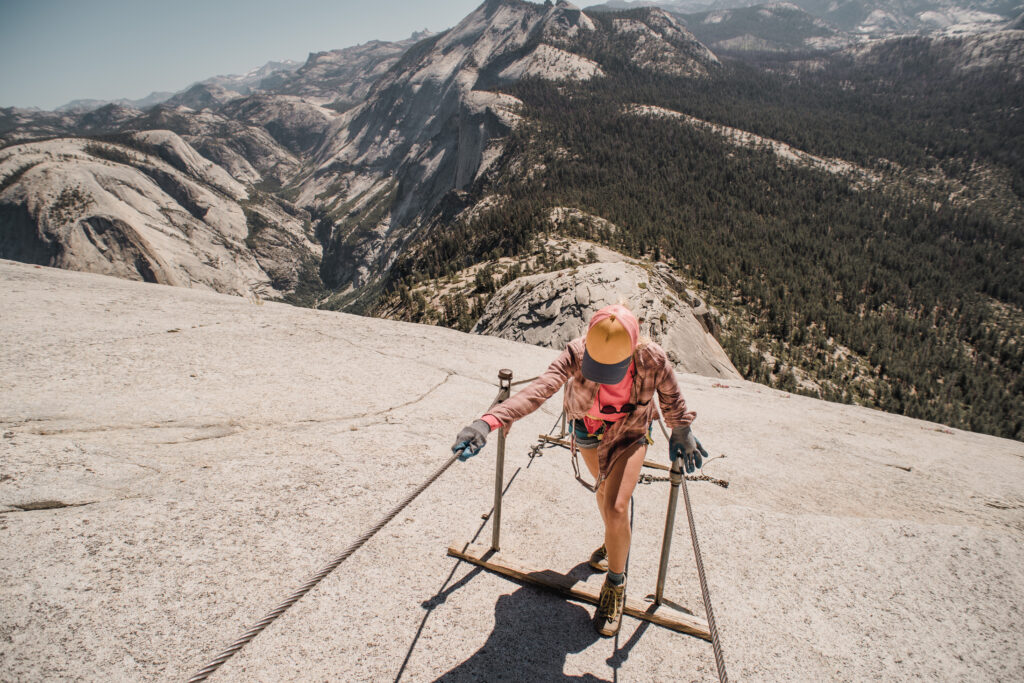
Gear List for the Half Dome Hike
The top messages people send me about the Half Dome hike are gear-related. To help, here’s my basic packing list. You can also read my post; The Best Gear from Backcountry.com that will link you to great suggestions
Via Ferrata Set
Iike these ones from CAMP, Black Diamond, and Salewa or another well-known climbing brand like Petzl. A via ferrata set has two lanyard arms and carabiners, so you’ll be constantly connected to the cable. The device is designed to absorb energy if the user falls. Though, be sure to buy a via ferrata set that’s rated to hold your body weight. According to Black Diamond, most systems on the market are designed to hold a 176 pound climber. If you weigh more, you may need to incorporate a secondary system. And learn how to correctly use your safety gear: Here’s a good intro. Lastly, don’t be tempted to buy a climbing leash that’s not built to hold you if you fall.
Hiking Boots
Please don’t show up at the national park in Adidas clamshell shoes. To safely tackle Half Dome, you need hiking footwear with ankle and foot support and good traction. My favorite pair is the women’s Danner Mountain 600. No matter what, break in your shoes before you go, which helps prevent you from getting blisters, hot spots, or foot fatigue.
Climbing Harness
I like the women’s Black Diamond Momentum Harness
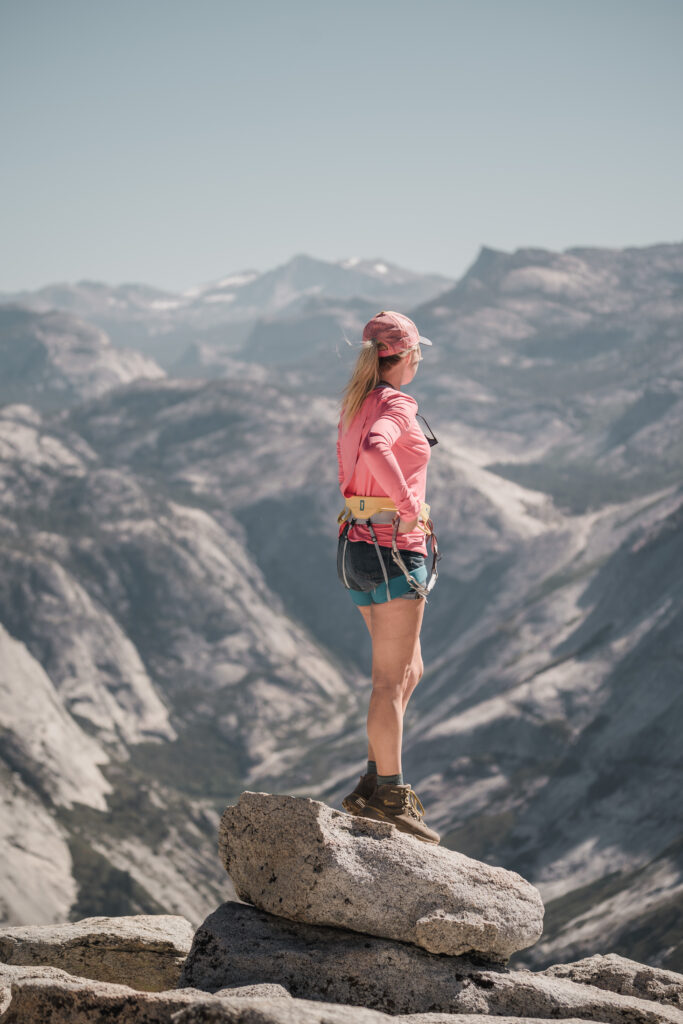
Work Gloves
Choose a pair with grip; I like gardening gloves, because they are inexpensive
Headlamp
You may want to start in the dark to avoid crowds on the cables, summer heat, or both. There’s also a chance that your group could take longer than planned. A headlamp is always a good call. My favorite is the Petzl Swift RL, because it’s rechargeable, powerful, and the output adapts to the surroundings. But Energizer makes budget-friendly options that work pretty well, too.
Water
Fill your bladder or reusable water bottles with a gallon of water to bring on the hike, recommends the NPS. Either vessel can be carried in a backpack. The only treated water along the trek is at the Vernal Fall Footbridge, which is less than one mile from the trailhead. Warning: Don’t drink the water from the Merced River without treating it.
Snacks
Pack enough of calories to keep you fueled on the way up and the way back. Descending is also a lot of work!
Half Dome Hike: Season & Permit
Each October, the rails that support the metal cables are removed, and the cables lie flat on Half Dome’s granite face all winter. Then, in May, the rails are reinstalled. A permit is required to do the hike from May to October.
The annual lottery for day hike permits is held each March. Or, if you want to backpack and camp at Little Yosemite Valley—like Dylan and I did—you can request a Half Dome permit alongside your wilderness permit: 50 are available by reservation and 25 are available the day before you go. You can pick the latter up at the wilderness centers—but it’s first-come, first-served, so it’s a gamble.
That said, if you can backpack, definitely do! Carrying my backpacking gear up to the campsite was really tough, because it’s a steep trail. But Little Yosemite Valley is magical and worth an overnight. I also found the itinerary less exhausting, because our mileage was split across two days. And, on summit day, you can carry less gear, because you’re so much closer to the cables.
Never gone backpacking but want to? Read my blog, “How to Get Started Backpacking.”
Leave No Trace: Half Dome Hike
Plan to pack out 100% of your trash—including toilet paper—because there are no trash receptacles along the trail. Also, only a few toilets are installed at Vernal Fall Footbridge, close to Emerald Pool, near the top of Nevada Fall, and in Little Yosemite Valley. Otherwise, if you need to go poop, bury your waste six inches deep and 100 feet away from water and trails.
As cute as they are, NEVER feed critters or leave your pack unattended, because it could attract animals. (Yosemite National Park even charges a $5,000 fine for feeding wildlife.)
Read more about Leave No Trace principles in my blog, “Outdoor Ethics: Leave No Trace and Geotagging.”
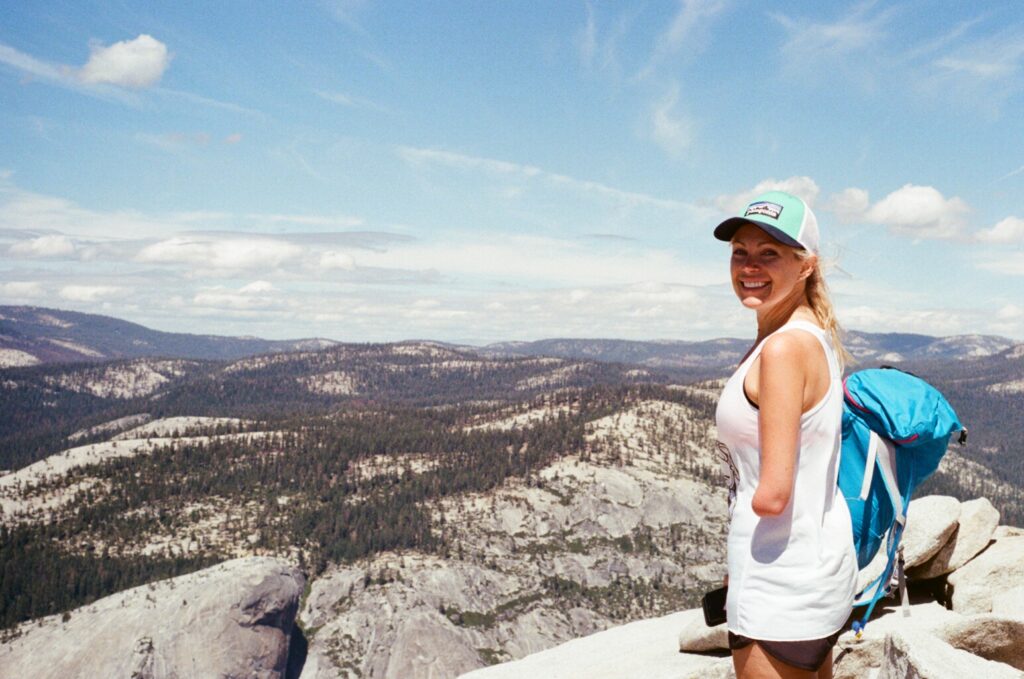
Why You Should Hike Half Dome
I don’t want to deter others from experiencing one of the most majestic hikes in the world. My first climb on Half Dome absolutely changed my life. It was my inaugural understanding of Type II fun: I faced an immense challenge, physically and mentally, that expanded my mind. I felt deeply exhausted and proud that I’d finished what I started. Despite that I needed help along the way, completing the cables climb showed me that I was capable of doing more extreme and technical outdoor pursuits. That realization catalyzed SheLift and my entry into other adventure sports.
However, it would be immoral for me to paint a perfect picture of this route. I was in over my head on that first trip. I love that hikers can all share our experiences online. Yet, I think that social media and YouTube footage can also perpetuate a harmful perception that hiking Half Dome is more accessible than people should believe it to be. Half Dome is dangerous, especially when not approached responsibly. I’ve seen people attempt this arduous day with little to no food, water, or weather layers in regular sneakers—or flip-flops! When people are not prepared, physically or logistically, this journey becomes perilous for them and everyone else.
If you snag a permit—and I hope you do—please prepare well for this challenging chance of a lifetime.
Comments +